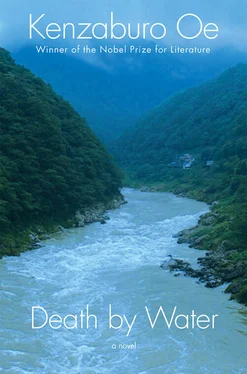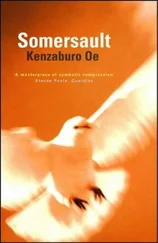“Mr. Koga has spoken with the attorney who’s apparently waiting somewhere, along with Mrs. Koga, and they’ve come to a final decision. They’re insisting on having every single line pertaining to Mr. Koga’s relationship with Unaiko eighteen years ago cut from the script. If those terms aren’t accepted, Koga says Unaiko will continue to be held prisoner here. (He’s in full-on yakuza mode now and doesn’t seem to care that what he and his people are doing is felony kidnapping.)
“And when it comes time for the performance tomorrow night, he says, the show will not go on; if their terms aren’t met, they will crush it into oblivion! And if there should be any further attempts to stage the unrevised play, they’ll use the current version of the script, which is in their possession, as the basis for a lawsuit for defamation of character. This is their final word on the subject — they’re calling it an ultimatum. Mr. Koga will be standing by throughout the night, waiting for Unaiko to soften her position and agree to their terms. Oh, and also, he absolutely refuses to act out the deleted parts, Unaiko’s perfectly reasonable request for closure be damned.
“But listen, Kogito, I just came from telling Mr. Koga that the play really does need to go on, for reasons that have nothing to do with him or his niece. You both know the basic story, of course: the farmers in this area were suffering from tremendous economic difficulties, and Meisuke organized an uprising. Not only men but women and children, too, assembled under the flag he hoisted aloft. They went out and fought in the uprising and came back with a victory. Meisuke alone was captured and ended up dying in prison. Some years passed, and once again the farmers found themselves in dire straits. The Meiji Restoration was in full swing and the country was in a state of upheaval, with the feudal system in ruins and the farmers being persecuted by the emissaries of the central government. If the weakest links — the women and children — hadn’t banded together and staged an uprising, nothing would have changed. The strategy for the second insurrection came from a supernatural source: Meisuke’s mother sent her young child, Meisuke II (whom she believed to be the reincarnation of the original Meisuke), to the grassy hillock known in local lore as the favorite napping spot of the Destroyer. According to legend, Meisuke II was joined by the spirit of his older brother, and they lay down side by side in the grass while the original Meisuke’s spirit gave his young namesake some tactical advice about staging a successful uprising. The adversary this time wasn’t the forces of the feudal fiefdom but, rather, government soldiers. Those troops tried to power through the insurrectionists’ front lines in Okawara, but the small children Meisuke II had enlisted threw themselves across the soldiers’ path and began weeping and wailing in unison, and the alliance of crying children and fierce women managed to drive the soldiers away. The government’s emissary to the district was so humiliated by this unexpected defeat that he committed suicide.
“The truth is, I learned a lot of fascinating details about this facet of local history from reading the script, and I think putting on this play would have great value even if it only served to remind people from around here about this inspiring story from the past. So I really think it’s worth fighting for.
“And now, that brings me to something a wee bit personal I’d like to ask you, Unaiko. In a play supposedly focusing on a legendary uprising, why did you feel the need to include the story of how you were raped at the age of seventeen by your uncle? Why couldn’t you have put those matters aside and let the play end with a lively reprise of the battle chant — you know, ‘Women warriors, here we go!’ type of thing. If you did it that way, I assure you Mr. Koga wouldn’t raise any objections at all. So I guess my question to you is: Why don’t you accept his terms and move on?”
“Well, Daio,” Unaiko began, turning to face him. “The first thing I’d like to say, just for the record, is that all those events are mentioned in the chant heard every year at the local Bon Odori celebrations: the stoning to death of Meisuke II; the rape Meisuke’s mother was subjected to (and not just rape, but gang rape); and the way she had to be carried home on a makeshift stretcher because her injuries were so severe. I know several scenes depicting those occurrences were also included in the early drafts of the screenplay for the movie we recently screened up at the Saya. However, they were deleted when the project reached the production stage, and that part of the story has never been expressed in visual form. The film ends in the way you described, Daio: with a reprise of Meisuke’s mother’s rebel yell, a scene in which all the women who took part in the uprising are chanting together and their voices fill the air with a rousing chorus. It’s really gorgeous the way their chanting mingles with the Beethoven piano sonata on the sound track — and even after the movie is over, the viewer is left with a sort of musical afterglow.
“I put that ending in my play as well, just as it was in the movie, with the same uplifting chorus of voices. What I did differently in my version, of course, was to actually describe the horrific things Meisuke’s mother and her child experienced in a narrative chant. This may seem a little confusing, but I would be onstage, still dressed as Meisuke’s mother, except that I would have turned into a medium channeling her spirit. And after I had finished chanting about the horrendous things that happened I would begin shedding my Kabukistyle costume right there on the stage, without any assistance, until I was back to the way I had started in the very first scene: as a modern-looking young woman in a navy-blue dress. At that point — playing myself now — I would be transformed into a medium possessed by the spirit of my seventeen-year-old self. Speaking through me, the young girl would tell the story of how she was raped by her uncle, who by his own account — that is, according to his published autobiography — was one of the founding architects of this nation’s modern system of education. She would explain that a few months later, after her pregnancy was discovered, her aunt forced her to get an abortion, saying it was necessary in order to protect the nation’s educational system.
“Presumably the man would want to contradict some aspects of the story, so if my uncle hadn’t shown up, we were going to have an actor sitting in the audience, ready to step into the role. However, I would be poised to mount a counterattack, and any attempts to discredit me or make himself look better would be swiftly shot down. As I stood there in triumph, the other female characters would appear onstage and gather around me. Then we would recite the battle cry in unison. As the chanting swelled and the voices soared, that would be the finale, with the women exhorting one another to go forth and wage the eternal battle, today and forevermore — because it’s a fact of life that there will always be injustice and there will always be a need for women warriors to fight the good fight. And then a number of no-longer-crying children and their newly cheerful mothers, all dressed in present-day costumes, would join the group onstage, and they would be chanting as well.”
Unaiko fell silent, her speech at an end. She had been staring straight at Daio the entire time she was talking, and he had never once averted his gaze. Now, though, he lowered his head. In the sudden stillness, the sounds of the wind and the rain outside grew even louder. After a second or two Daio stretched his arm overhead, releasing the accumulated tension, and I leaned back and did the same.
Читать дальше










